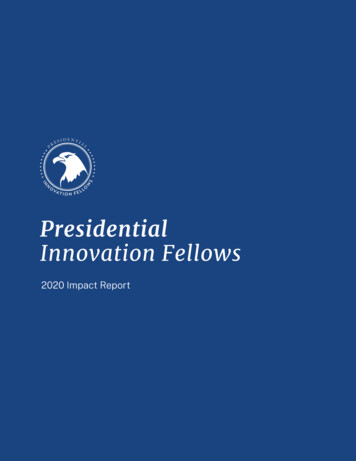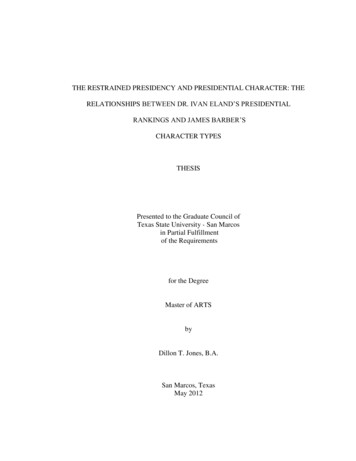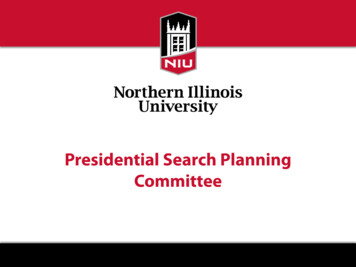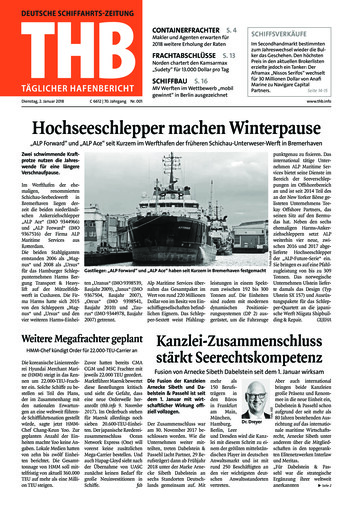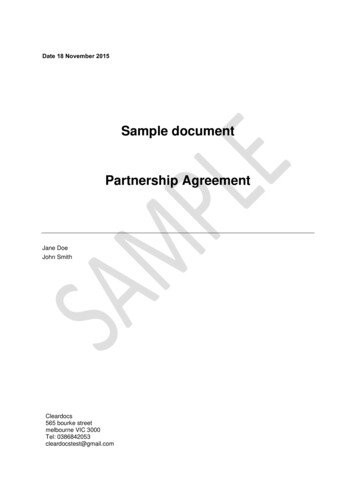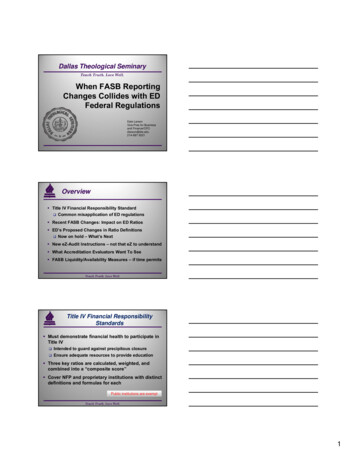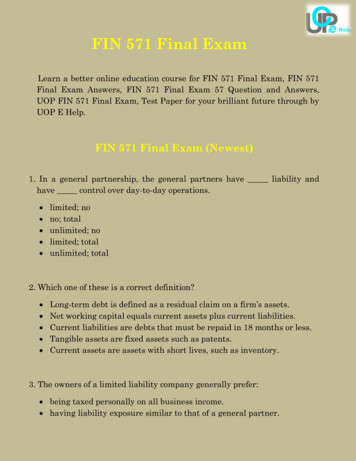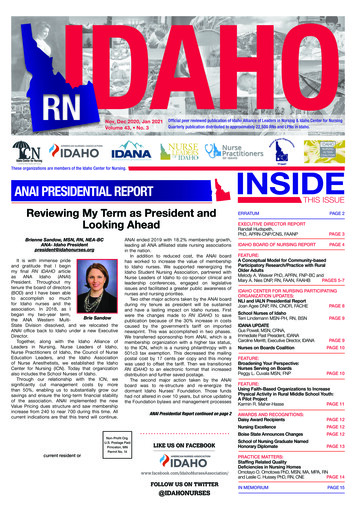
Transcription
IDAHONov, Dec 2020, Jan 2021Volume 43, No. 3Official peer reviewed publication of Idaho Alliance of Leaders in Nursing & Idaho Center for NursingQuarterly publication distributed to approximately 22,500 RNs and LPNs in Idaho.INSIDEThese organizations are members of the Idaho Center for Nursing.ANAI PRESIDENTIAL REPORTTHIS ISSUEReviewing My Term as President andLooking AheadBrienne Sandow, MSN, RN, NEA-BCANA- Idaho Presidentpresident@idahonurses.orgIt is with immense prideand gratitude that I beginmy final RN IDAHO articleasANAIdaho(ANAI)President. Throughout mytenure the board of directors(BOD) and I have been ableto accomplish so muchfor Idaho nurses and theassociation. In 2018, as Ibegan my two-year term,Brie Sandowthe ANA Western MultiState Division dissolved, and we relocated theANAI office back to Idaho under a new ExecutiveDirector.Together, along with the Idaho Alliance ofLeaders in Nursing, Nurse Leaders of Idaho,Nurse Practitioners of Idaho, the Council of NurseEducation Leaders, and the Idaho Associationof Nurse Anesthetists, we established the IdahoCenter for Nursing (ICN). Today that organizationalso includes the School Nurses of Idaho.Through our relationship with the ICN, wesignificantly cut management costs by morethan 50%, enabling us to substantially grow oursavings and ensure the long-term financial stabilityof the association. ANAI implemented the newValue Pricing dues structure and saw membershipincrease from 240 to near 700 during this time. Allcurrent indications are that this trend will continue.current resident orANAI ended 2019 with 18.2% membership growth,leading all ANA affiliated state nursing associationsin the nation.In addition to reduced cost, the ANAI boardhas worked to increase the value of membershipto Idaho nurses. We supported reenergizing theIdaho Student Nursing Association, partnered withNurse Leaders of Idaho to co-sponsor clinical andleadership conferences, engaged on legislativeissues and facilitated a greater public awareness ofnurses and nursing priorities.Two other major actions taken by the ANAI boardduring my tenure as president will be sustainedand have a lasting impact on Idaho nurses. Firstwere the changes made to RN IDAHO to savepublication because of the 30% increase in costscaused by the government’s tariff on importednewsprint. This was accomplished in two phases.We transferred sponsorship from ANAI, which is amembership organization with a higher tax status,to the ICN, which is a nursing philanthropy with a501c3 tax exemption. This decreased the mailingpostal cost by 17 cents per copy and this moneywas used to offset the tariff. Then we transitionedRN IDAHO to an electronic format that increaseddistribution and further saved postage.The second major action taken by the ANAIboard was to re-structure and re-energize thedormant Idaho Nurses’ Foundation. Those fundshad not altered in over 10 years, but since updatingthe Foundation bylaws and management processesNon-Profit Org.U.S. Postage PaidPrinceton, MNPermit No. 14ANAI Presidential Report continued on page 2LIKE US ON LLOW US ON TWITTER@IDAHONURSESERRATUMPAGE 2EXECUTIVE DIRECTOR REPORTRandall Hudspeth,PhD, APRN-CNP/CNS, FAANPPAGE 3IDAHO BOARD OF NURSING REPORTPAGE 4FEATURE:A Conceptual Model for Community-basedParticipatory Research/Practice with RuralOlder AdultsMelody A. Weaver PhD, APRN, FNP-BC andMary A. Nies DNP, RN, FAAN, FAAHBPAGES 5-7IDAHO CENTER FOR NURSING PARTICIPATINGORGANIZATION UPDATES:NLI and IALN Presidential ReportJoan Agee DNP, RN, CNOR, FACHEPAGE 8School Nurses of IdahoTerri Lindemann MSN-PH, RN, BSNPAGE 9IDANA UPDATEGus Powell, MSN, CRNA,Immediate Past President, IDANACaroline Merritt, Executive Director, IDANAPAGE 9Nurses on Boards CoalitionPAGE 10FEATURE:Broadening Your Perspective:Nurses Serving on BoardsPeggy L. Cuvala MSN, FNPPAGE 10FEATURE:Using Faith-Based Organizations to IncreasePhysical Activity in Rural Middle School Youth:A Pilot ProjectKarmin R. Maher-HassePAGE 11AWARDS AND RECOGNITIONS:Daisy Award RecipientsPAGE 12Nursing ExcellencePAGE 12Boise State Announces ChangesPAGE 12School of Nursing Graduate NamedHonorary DiplomatePAGE 13PRACTICE MATTERS:Staffing Related QualityDeficiencies in Nursing HomesOmotayo O. Omotowa PhD, MSN, MA, MPA, RNand Leslie C. Hussey PhD, RN, CNEPAGE 14IN MEMORIUMPAGE 15
Page 2 RN IdahoNovember, December 2020, January 2021ANAI Presidential Report continued from page 1and changing the investment structure, we haveseen a 10% overall increase in the conservativelyinvested fund balance over two years.ANAI’s goal in partnering with the other Idahonursing professional organizations in establishingthe ICN was to form a collaborative group ofindividual membership organizations that shareinformation and resources to build a strongframework of cooperation on common issues andto present a unified nursing voice to the publicand the Idaho Legislature. Through the partnershipof these organizations’ boards of directors, wehave elevated the nursing profession’s presence inaddressing political and social issues that impactthe health of Idaho citizens and the ability ofnursing to influence them. The greatest outcomeof the ICN has been the power to state in publicforums, such as the Idaho Legislature, that ourleadership speaks for the collective Idaho nursingcommunity of 27,000 licensed RNs and 3,500LPNs, who live in every legislative district in thestate. Thus, today legislators, the governor’s officeand other public organizations look to the ICN andANAI for nursing input into public policy.The issues facing nurses, professional nursingorganizations and the healthcare of Idahoans areongoing, and despite all we have accomplished,there is still much to do. Therefore, it is withgreat confidence that I introduce the incomingANAI President, Dori Healey, MSN-RN, MBA-HA,CPPS. Dori will take office on January 1, 2021,after serving as the president-elect for the pasttwo years. She has been a co-chair of the LEAPclinical conference planning committee, activein our legislative work and has attended the ANALeadership and ANA Membership Assembly in2019 and 2020.Dori began her nursing career as a licensedpractical nurse (LPN). She spent nine years workingin various roles as an LPN. After completing herRN, she pursued her master’s in nursing with anemphasis on education, an additional master’sdegree in healthcare administration, and recentlycompleted her clinical nurse specialist (CNS) postmaster’s certificate. Dori is committed to creatingan inclusive association and strengthening thepartnerships between nursing organizations. Aneffort that ANAI will initiate is engaging LPN’sin ANAI. Because LPNs do not have a formalorganization to represent them in Idaho, theirspecific concerns are not well addressed. There isan increased need for LPNs in clinical settings andIdaho has a shortage of them. At this time, we canhave LPNs as ANAI members and 2021 shouldsee that goal move forward. Dori has a passion tolead, improve nursing culture, and create a robustdynamic association that fosters nurses throughoutthe state of Idaho.Dori is married and a mother of two children.She was recently elected to a seat on herlegislative precinct committee. She spends timevolunteering in the community, including being thechair for Idaho’s Ryan’s Case for Smiles, a nationalorganization that provides children with uplifting,cheerful pillowcases during their medical treatment.Dori is also dedicated to raising money forheadstones for children to give closure to parentswho may not be able to afford a headstone marker.When there is a need in the community, she is theperson who steps in and acts.Please join me in welcoming Dori Healey to hernew role as ANAI president!Erratum:Correction toPowell(2020, August)In the article “Clarifying ProfessionalCredentials” by Gus Powell (RN Idaho. August,2020) the title was incorrect. The title shouldappear as follows: Idaho CRNAs Responding toCOVID-19, 20201tpeS–20J u n e 1, 2 0BoiseCarole Krahn-KibbleTamra AnesMichelle StimakMelanie KanawyerJessica EmoryHeather WhippsSarah LlewellynSage IsaacsValerie LehmerSydney YoungCatherine BurgerJudith AllenPamela GehrkeNikela HarrisJohanna ButlerRachel AavangCaldwellKristen StoryAmber CraigChubbuckDominique ClemonsCoeur D’AleneCarol WilliamsCamey YeagerJaimie CurtisBarbara PaceFilerEmily JonesGarden CityDillan McGuireRuth TretterHauserMcKaylin ShireyHaydenMaggie NiewiarowskiRN Idaho is published byIdaho Center for Nursing6126 West State St., Suite 406Boise, ID 83703Direct Dial: 208-367-1171Email: rnidaho@idahonurses.orgWebsite: www.idahonurses.nursingnetwork.comRN Idaho is peer reviewed and publishedby the Idaho Center for Nursing. RN Idahois distributed to every Registered Nurse andLicensed Practical Nurse licensed in Idaho,state legislators, employer executives, and Idahoschools of nursing. The total quarterly circulationis over 26,000. RN Idaho is published quarterlyevery February, May, August, and November.Editor:Sara F. Hawkins, PhD, RN, CPPSEditor Emerita:Barbara McNeil, PhD, RN-BCExecutive Director:Randall Hudspeth, PhD, MBA, MS, APRN-CNP,FAANPember sMgninrutN ew & R esemocleoWA NA I d a hBlackfootBetty AtwellIDAHOIdaho FallsKelsie PfeifferJami LieberLewistonPam SpicklerSeth SixEsther SpataroMeridianTracie McfarlandVirginia WadeKate BarnesLynda PeelValeda GreenspanPocatelloGrace JacobsonRigbyTrisha MartinSpirit LakeAmanda JohnsonTroyFrancie TylerEditorial Board:Michelle Anderson, DNP, APRN, FNP-BC, FAANPSandra Evans, MAEd, RNPamela Gehrke, EdD, RNBeverly Kloepfer, MSN, RN, NP-CKaren Neill, PhD, RN, SANE-A, PF-IAFNGus Powell, MSN, CRNAKatie Roberts, MSN, RNLaura J. Tivis, PhD, CCRPRN Idaho welcomes comments, suggestions,and contributions. Articles, editorials and othersubmissions may be sent directly to the IdahoCenter for Nursing office via mail or e-mail. Visit ourwebsite for information on submission guidelines.For advertising rates and information, pleasecontact Arthur L. Davis Publishing Agency, Inc., POBox 216, Cedar Falls, Iowa 50613, (800) 626-4081,sales@aldpub.com. ICN and the Arthur L. DavisPublishing Agency, Inc. reserve the right to reject anyadvertisement. Responsibility for errors in advertisingis limited to corrections in the next issue or refund ofprice of advertisement.Acceptance of advertising does not implyendorsement or approval by the Idaho Center forNursing or by any professional nursing organizationthat is affiliated with the Idaho Center for Nursing, ofproducts advertised, the advertisers, or the claimsmade. Rejection of an advertisement does not implya product offered for advertising is without merit, orthat the manufacturer lacks integrity, or that theseassociations disapproved of the product or its use.The affiliated nursing organizations and the ArthurL. Davis Publishing Agency, Inc. shall not be heldliable for any consequences resulting frompurchase or use of an advertiser’s product.Articles appearing in this publication expressthe opinions of the authors. They do notnecessarily reflect views of the staff,board or membership of affiliatednursing organizations, or those of thenational or local associations.Twin FallsLisa JensenAnnette RobillardWendy SimmonsMiddletonKimberly ElmoreVacavilleAlan MasisNampaSarah MartinMichele LengenfelderJon CriswellLeonie SutherlandWeiserGinger WatkoJOIN ANA IDAHO TODAYWE NEED YOU!Membership applicationhttp://nursingworld.org/joinana.aspx
November, December 2020, January 2021RN Idaho Page 3EXECUTIVE DIRECTOR’S REPORTMaking Idaho’s Professional Nursing OrganizationsRelevant to Nurses: Part TwoRandall Hudspeth PhD, APRN, FRE, FAANPExecutive Director, Idaho Center for Nursingrandhuds@msn.comWithout a doubt I havea bias view of what nursesandnursingassociationscontribute to both the healthof Idahoans and to nursesindividually. I also have a biasthat all nurses can benefitby contributing their partand by joining a professionalorganization.Associationsare like a team sport. Thestronger and bigger the teamRandall Hudspeth(association) is, the better theoutcomes. I also have a belief that everyone wants tobe a part of a winning team, and Idaho nurses haveevolved into a winning team.I realize, like many of you, that a nursing associationin a small rural state like Idaho will struggle to exist andthat most of us look at paying a membership fee withthe question “what is in this for me?” That is a verylegitimate question. The answer is that an individualnurse gets more from an association than they realize.In my long career I have seen all nurses benefit fromthe work of associations in terms of expanded scopesof practice for LPN, RN and APRNs, better, morenumerous and consistent education opportunities togo from Associate-RN to BSN-RN; compact licensureimplementation, representation on governmentalpolicy making committees, and coming together tosupport programs for the betterment of Idahoans suchas Medicaid expansion, child safety, immunizationeducation and the support of community volunteerhealth screening clinics that are sponsored by manydifferent organizations and staffed by nurses.Sustainability is an issue and to mitigate it thenursing associations came together and formed theIdaho Center for Nursing (ICN). These sustainingassociations are the American Nurses Association ofIdaho (ANAI-formerly the Idaho Nurses Association),Nurse Leaders of Idaho (NLI), Nurse Practitioners ofIdaho (NPI), Idaho Association of Nurse Anesthetists(IDANA), School Nurses of Idaho (SNOI), Consortiumof Nursing Education Leaders (CNEL) and the nonprofit nursing philanthropy Idaho Alliance of Leadersin Nursing (IALN). They entered into a mutualMemorandum of Understanding with each other toshare resources such as the office, staff, accounting,web-hosting, shared liability insurance coverage, andin some cases hosting shared clinical and legislativeconferences. These endeavors have resulted in costsavings for each organization.The ICN encourages nurses to belong to someprofessional nursing membership organization. Thisis for the good of the profession and for the individualnurse. Fortunately, all nurses do get the benefits fromorganizational efforts that are supported by the fewwho do belong.What are the issues being addressed by theassociations that impact Idaho nurses? ADVOCATING FOR NURSES: This yearnursing was well represented in legislativearenas and on the governor’s HealthcareTransformation Council of Idaho. Nursingwas successful to defend existing legislationthat makes it a felony to attack a nurse whois on duty, when some groups wanted toeliminate penalties for people who had long orshort-term psychological issues as a reasonfor attacking a nurse. Nursing supportedthe NPI sponsored legislation on globalsignature recognition that passed. Nursinghas also been engaged with telehealth accessdiscussions and the profession supportedthe IDANA proposal to use the term “nurseanesthesiologist” as a name descriptor. Thenursing organizations have been engaged withpolicies and procedures that guide PPE use, reuse and overall public safety issues related tocoronavirus. NURSING WORKFORCE ANALYSIS: TheICN is now gathering data for the 2020 IdahoNursing Workforce Report. The report will detailIdaho’s current supply of licensed nurses,the education outputs of new nurses, andthe future job demand for nurses in Idaho.Future workforce capacity analyzes the impactof nurse retirements against their replacementby new graduates and the impact on nursingneed by the population increases through inmigration to Idaho and by the aging of thegeneral population that will have ever increasinghealthcare needs. The workforce reportsof 2016 and 2018 have become valuabledocuments to determine workforce trends andto guide future planning in Idaho. UPCOMING CONCERNS WHERE NURSESWILL WANT TO HAVE INPUT: (1) SchoolNurses – As the pandemic continues andschools are in session, the important workof school nurses needs to be addressed. Thebottom line is that because of decades ofunderfunding and school districts needing tocut costs and programs to meet the very basiceducational needs, school nurse positionshave been and are still a target for cuts. Todayit is not uncommon for a school district tohave one nurse covering multiple schools, orno school nurse at all. (2) Worker’s CompClaims related to coronavirus — Althoughthis has not been an issue in Idaho yet, weare aware that hospitals in other states arefighting against worker compensation claimsfiled by nurses when they became coronaviruspositive and could not work. The argument isthat the contact cannot be confirmed to be inthe workplace when there is also communityspread. (3) Negotiating student clinicalplacement alternatives so that the pipelineof future nurses is maintained and that clinicalsite alternatives have sufficient variety so thatno one site is overwhelmed. (4) Maintainingnursing education programs by supportingnurse faculty salaries that are equitable tothose paid in hospitals and other agencies. (5)Maintaining student academic portabilityby continuing the current system of statewidecredit articulation between associate andbaccalaureate degree programs, (6) Seekingstudent nurse scholarships to Idahostudents to become nurses, and (7) Workingwith the Board of Nursing to evaluatethe impact and outcomes of the continuedcompetency requirements that impacted LPNsin 2020 and will impact Registered Nurses in2021 when they renew their licenses.The professional nursing organizations in Idahoare well organized, have engaged nurses on theiroversight boards and have goals to be inclusive ratherthan exclusive. They support each other and the ICNand ANA-Idaho have also actively supported the IdahoNursing Student Association (INSA) to re-establishas a constituent organization of the National StudentNurse Association. Even though not all nurses in Idahoare members of a professional organization, theseorganizations do speak for their representative nursespecialties, and the Idaho Center for Nursing andANA-Idaho represents all Idaho nurses.In summary, nurses can be proud of ouraccomplishments and of our representation inIdaho and nationally. Nurses are well representedwithin the state, but a continued and ever-increasingengagement by all nurses is what will sustain forwardgrowth of the profession.Program for Recovering NursesAddiction Intervention and RecoveryServices for Nursing ProfessionalsSEEKING LPNs & CNAsHealth/DentalRetirement PlanDifferential PayPaid Time OffDo you know a nurse or a colleague who needs help fordrugs/alcohol or mental health problems?Please contact us for assistance. This program is analternative to disciplinary action offered by the BON.For immediate assistance, please call us at 800-386-1695www.southworthassociates.net
Page 4 RN IdahoNovember, December 2020, January 2021IDAHO BOARD OF NURSING UPDATEThe Idaho State Legislature established the IdahoBoard of Nursing in 1911 to regulate nursing practiceand education for the purpose of public protection.Since its inception, the Board has continuallyempowered individuals to attain their highest careergoals in the profession of nursing while providing Idahocitizens the best possible health care. As part of thisfocus, the Board continually assesses the strategicdirection of the profession of nursing in Idaho.The Board is excited to announce the developmentof a new strategic plan which was approved by theBoard at the July 2020 Board meeting. The strategicplan outlines many of the priorities and activities thatthe Board will pursue through 2024. It is designed asSCHOOL OF NURSINGCCNE ACCREDITED TO 2030Complete Your Bachelor’sDegree in Nursing OnlineAre you aBroncoNurseAlumni?Connect with us & shareyour story, and you couldbe featured in School ofNursing or in Boise StateNews! Contact us via email.We areHIRINGa BSNApply by Nov. 23 for theLaboratory OperationsSpecialist (BSN min. Qual)Apply online throughBoise State & Page UP:493092Nursing@BoiseState.edua framework to elevate the practice of nursing whileensuring that we protect the public’s health, safety,and well-being. In addition, the new strategic plan isaccompanied by an updated vision and mission.Vision: Exceptional nurses. Exceptional care.Mission: The Idaho Board of Nursing elevatesthe practice of nursing by regulating, supporting, andempowering nurses to perform at the highest level oftheir licensure to protect the public’s health, safety, andwell-being.The 3 goals identified in the strategic planinclude:1. Enhance public safety, health, and well-being byincreasing the availability and competence of thenursing workforce.2. Facilitate the appropriate amount and type ofregulation to ensure quality education, effectivelicensure, and evidence-based practice.3. Improve communication and customer serviceby optimizing technology and processes.The Board looks forward to collaborating withstakeholders across the state to regulate, support,and empower the profession of nursing. For additionalinformation, please visit our website at: https://ibn.idaho.gov/.On June 3, 2020, Governor Little issued ExecutiveOrder 2020-10 relating to the organization of selfgoverning agencies. Specifically, the order reorganizes49 Boards under an umbrella agency called the Divisionof Occupational and Professional Licenses (IDOPL). TheBoard of Nursing is one of the Boards included in thereorganization.The purpose of this action is to seek efficienciesfrom the combined organization. Such efficienciesinclude the consolidation of information technologysystems and other functions that Boards rely on toprovide services. The Executive Order requires the 49Boards to be collocated to provide a one-stop shopfor state licenses. As a result, all Boards will move theiroperations to the state’s Chinden Campus. The Boardof Nursing office will be located there by October 1,2020.The Order also establishes that a DivisionAdministrator, appointed by the Governor, shall overseethe activities of the Boards including administrative rulechanges, budgets, and strategic plans. On September1, 2020 Governor Little appointed Russ Barron to thisDivision Administrator position. Russ will also continueto serve as the Executive Director for the Board ofNursing during this transition that is expected to takeup to a year to complete. This reorganization is intendedto help all Boards fulfill their respective missions andstrengthen and improve services where possible.
November, December 2020, January 2021RN Idaho Page 5FEATUREA Conceptual Model for Community-based ParticipatoryResearch/Practice with Rural Older AdultsMelody A. Weaver, PhD., APRN, FNP-BCAssistant ProfessorCollege of NursingIdaho State Universityweavmelo@isu.eduMary A. Nies, PhD, RN, FAAN, FAAHBDirector of Nursing Research, Professor JointAppointment MPH ProgramIdaho State Universityniesmary@isu.eduIntroductionIn this year of the Nurse and Midwife (WorldHealth Organization, 2020) we, as nurses, whetherpracticing, researching or both have an opportunityto focus on our fastest growing population, theolder adult. Why model development? In an effortto provide consistency and focus for both theresearcher and community-based nurse we musthave common understanding of the issues andchallenges in reaching out to rural older adultsfor inclusion in community-based participatoryresearch/practice.We live in an aging nation. Expectations are by2030 that 20 percent of U.S. residents will be 65years and older (Ortman, Velkoff & Hogan, 2014).Beaton (2018) reported that national health careexpenditures will reach 5.5 trillion by 2026 dueto a 5.5% annual growth of those 65 and older.Johnson and Parnell (2016) discussed the shiftingdemographic of the American population in theirsummary of U.S. Census data. All cohorts of thepopulation age 65 and older will outpace overallpopulation growth over the next 20 years. Babyboomers are entering the older adult cohort at arate of 8,000 to 10,000 per day and advances inmedicine and technology are increasing the lifeexpectancy of the oldest old (age 85). In addition,according to Johnson and Parnell (2016), the age100 and older population will increase by 168percent by the year 2040.By 2030, one in five individuals aged 65 andover will be living in rural communities (US CensusBureau, 2018). Although there is outmigrationof older adults from metropolitan areas to ruralareas (Johnson & Parnell, 2016) there continuesto be considerable aging in place, especially inrural communities. Young people are leaving tosearch for better opportunities, leaving older adultswith a deficit in caregivers. The majority of thispopulation is older women living in homes that arequite often no longer safe. According to Padilla(2017), for older adults living in these areas of lowpopulation density, physical and social isolationcan occur, compounded by lack of access to care,and a higher burden of chronic disease and death,frequently from preventable disease.In 2017 Beaton reported the top ten mostcostly chronic diseases for healthcare payers:cardiovascular disease, smoking-related healthissues, alcohol-related health issues, diabetes,Alzheimer’s disease, cancer, obesity, arthritis,asthma and stroke. Moy and colleagues (2017)added unintentional injury and lower respiratorylung disease. As the cost of healthcare risesit becomes imperative to address issues ofdisparity and attempt to close the gap betweenurban and rural/frontier populations. Tisminetzkyand colleagues (2017) in their study on researchpriorities to advance the health of older adultsnoted the highest-ranking priority is quality of life inolder adults with multiple chronic conditions (MCC),as well as issues regarding medications, role ofcaregivers, symptom burden, and novel models ofcare. In their comparison of Rural Healthy People2020 to the 2010 report Bolin, Bellamy, Ferdinand,Vuong, Kash, Schulze & Helduser (2015) foundlittle change in rural health priorities with access tocare remaining the top priority. All of these issuescome together to assist us in beginning to developan understanding of the needs that might beexperienced by older adults living in rural/frontierareas of the country.Therefore, focusing on issues that can improvequality of life for rural older adults creates animperative for academic researchers, as well as,community-based nurses, to collaborate witheach other and older adults, their families and thecommunity in building healthier ecosystems for thisaging-in-place population.Academic Researcher/Nurse ChallengesOlder adults are less likely to be included inresearch studies. Lacey and colleagues (2017) intheir systematic review of 32 studies examiningevidence for strategies for recruitment andretention of older adults in both randomizedtrials and observational studies found a lackof consistent use of strategies across studies,thus limiting generalizability of results. Olderadults have issues such as mobility, vision andhearing changes, multiple chronic conditions,and polypharmacy that can all contribute tothe challenges of, and the need for inclusion inresearch. Older adults living in rural areas areoften not included in research simply based ongeography. Assumptions abound about ruralolder adults’ inclusion in research including a lackof understanding on the part of the researcherin relation to health literacy, internet access,and computer literacy. All of these issues can bemitigated by the community-based nurse workingin partnership with the ent of community-dwelling older adults inrural communities. DiBartolo & McCrone (2003),in their seminal work, discuss barriers that includethe aforementioned issues surrounding physicalchanges, MCC, medication and literacy, as well asgeographic barriers such as lack of transportation;language barriers, cultural differences and fearof disclosure (Nies, Febles, Fanning & Tavernier,2018); issues about time, consent, trust,worldview conflicts, gender bias, incentives, androle interpretation (Holden, McDougald Scott,Hoonakker, Hundt, & Carayon,2015). Trust in“outsiders” can also hinder older adult participationin clinical research (Dautovich, Stripling, &Dzierzewski, 2014; Lor & Bowers, 2018). Mody andcolleagues (2008) summarized older adult inclusionin research as “targeting the specific strategiesto the condition, site, and population of interest,”as well as “anticipating potential problems andpromptly employing predeveloped contingencyplans” (p. 2040). A number of these issues as theyrelate to the researcher-participant tensions withrural older adults will be discussed in more detailwith a special focus on trust.Geography in rural/frontier areas can presenta problem for the researcher/nurse as well as theparticipant. Distance from the academic institutionand/or weather could be a factor, especially inparts of the country that experience severe winterweather, often making roads impassable. Beattieand colleagues (2018) in their review of nine studiesconducted with their team of dementia researchersin Australia suggest reaching out in an effort toincrease sample size by using research teams,such as the community-based nurse who mightlive in the area of interest.Time is a double-edged sword. A myth thatolder adults have all the time in the world is simplynot true. Discretionary time may be limited due tocaregiving responsibilities of either a spouse orgrandchildren, for instance. The time it takes tocomplete data collection can be burdensome forboth the participant and the researcher, especiallyin rural areas, making it challenging to be efficient(Holden, et al, 2015). Puts & colleagues (2017)summarize challenges of including older adultsin oncology studies recognizing that factorssuch as fatigue and prognosis, development ofstudy protocols with shorter duration phases andpossible need to schedule a second visit in orderto complete consent and data collection dueto participant fatigue. For many of these olderadults living in rural areas,
Page 2 RN Idaho November, December 2020, January 2021 RN Idaho is published by Idaho Center for Nursing 6126 West State St., Suite 406 Boise, ID 83703 Direct Dial: 208-367-1171 Email: rnidaho@idahonurses.org Website: www.idahonurses.nursingnetwork.com RN Idaho is peer reviewed and published by the Idaho Center for Nursing. volunteering in the community, including being the RN Idaho
